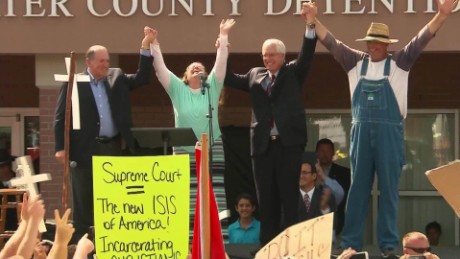A few things to bear in mind:
1. Pope Francis met with many individuals during his visits in Washington, New York, and Philadelphia, at various locations and events. For example, he met with Sister Norma Pimentel, who works with migrants on the Mexican border, at the Vatican nunciature in New York; she described her meeting and how it came about to America Media. At that same meeting he also met Sister Donna Markham, president of Catholic Charities USA. Pope Francis met with Sister Mary Scullion outside the Basilica of Sts. Peter and Paul in Philadelphia at the location of her “Grotto of Mary, Undoer of Knots,” dedicated to the homeless in Philadelphia, a meeting that was carried live on television. And he met with Stephen Schwarzman, a wealthy benefactor of Catholic schools, and spoke with him for several minutes at the school of Our Lady, Queen of Angels, in Harlem. The pope would have been introduced to many more people whom we may never know about: individual Catholics whom a Vatican official, or a local bishop or friend of the pope, felt was especially deserving of a visit—again, these would include Catholic donors, priests, men and women in religious orders, and so on.
2. Such meetings are arranged in several ways. Sister Norma told me that it was Archbishop Auza, the Permanent Observer of the Holy See to the United Nations, who invited her and Sister Donna to the nunciature for their early morning conversation. It is claimed that a “Vatican official” arranged the meeting with Kim Davis, which is vague. Does this mean someone in the Vatican curia? A local cardinal, archbishop or bishop? And why? In response to a request by the pope? Or perhaps as a way for a local bishop to encourage Ms. Davis, who, by the way, is not Catholic? (One unintended irony of this visit: I wonder what Ms. Davis’s own Apostolic Pentecostal church, which apparently does not believe in the Trinity, thinks of the office of the bishop of Rome.)
3. It’s hard to know how much the Pope Francis knew about each individual who was introduced to him during his long trip to the United States. Did he know much about Kim Davis before meeting her? Was he following her case before he entered the country? Did he learn about the controversy from a local bishop after he arrived? Or was her story quickly relayed to him in a receiving line? And how was it explained to him? “Holy Father, this is Kim Davis who…”
4. His words to her, “Be strong,” and his gift of a rosary seem to be the kind of thing the pope might do for anyone presented to him. The difficulty of trying to construe these words into Pope Francis’ support for a “liberal” or “conservative” political agenda is evident here. That is, he said almost the same thing to women religious in this country, sometimes widely viewed as “liberal”: “Be courageous!”
It’s also important to remember that the only source for what happened during the meeting is Ms. Davis, who would naturally be inclined to interpret the pope’s words and gestures as supporting her particular cause.
5. For those wondering what all of this means, it’s probably best not to interpret a meeting that the Vatican will not speak about, and also to be careful about swallowing wholesale the interpretation of those who would use this meeting to support their own agenda. Instead, there’s an easier and better option. Listen to the pope’s own words on the matter, which came in response to ABC’s Terry Moran’s question during the in-flight media conference back to Rome, about individual conscientious objection.
That is, if you want to know what the pope thinks about this issue, listen to what he says. And here the pope simply restated Christian theology: that is, everyone has the right to conscientious objection: “I can’t have in mind all cases that can exist about conscientious objection,” said the pope. “But, yes, I can say conscientious objection is a right that is a part of every human right. It is a right.”
In fact, now that we know that he met Ms. Davis, that first sentence indicates he is not in fact talking about her case in particular.
6. It’s ill advised to use a private visit with the pope to make political point. It’s also unfortunate that after the pope’s visit, during which he sought to reconcile divisions, during which he explicitly lamented political polarization in his speech to Congress and during which he sought to show how foolish the “culture wars” are, that his meeting with Ms. Davis may be used to score political points.
7. Most of all, despite what Ms. Davis said, a meeting with the pope does not “kind of validate everything.” Again, the pope meets with many people, some of whom he may know well, others of whom may be introduced to him as a reward for long service, and perhaps others who will use a meeting to make a political point. Meeting with the pope is a great honor, but it does not betoken a blanket blessing on “everything” one does. Not to put too fine a point on it, but Pope Francis also met Mark Wahlberg, and that does not mean that he liked “Ted.”




